On the strandline
Seaweeds
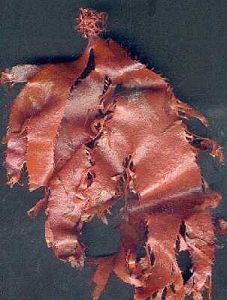
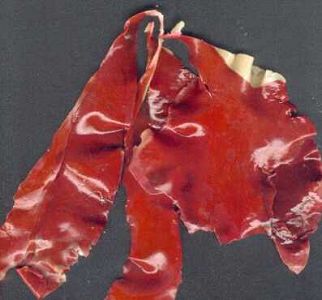 Depending on currents, winds and the tides, seaweeds may become detached from their anchoring points and deposited on the beach. Various wrack species, sugar kelp and bootlace weed are common. Red seaweeds can be more difficult to identify, and many do not have common names. Here are just two. On the left is probably Calliblepharis ciliata, with attractive fringes but sadly without a common name. The one on the right is Red Rags, Dilsea carnosa.
Depending on currents, winds and the tides, seaweeds may become detached from their anchoring points and deposited on the beach. Various wrack species, sugar kelp and bootlace weed are common. Red seaweeds can be more difficult to identify, and many do not have common names. Here are just two. On the left is probably Calliblepharis ciliata, with attractive fringes but sadly without a common name. The one on the right is Red Rags, Dilsea carnosa.
Shells
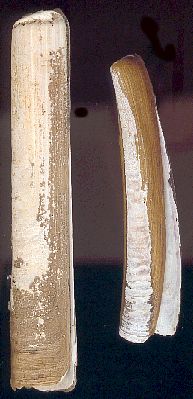
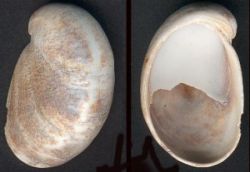 Various shells can be found, including Slipper Limpet (right), razor shells and Common Oyster. The Slipper Limpet, with a characteristic ledge inside, has arrived from North America, and now forms major colonies on the sea-bed of the Solent. It has a curious life history, starting out as male, and changing to female. The limpets form long stacks, with the female at the bottom and males above.
Various shells can be found, including Slipper Limpet (right), razor shells and Common Oyster. The Slipper Limpet, with a characteristic ledge inside, has arrived from North America, and now forms major colonies on the sea-bed of the Solent. It has a curious life history, starting out as male, and changing to female. The limpets form long stacks, with the female at the bottom and males above.
On the left are two species of razor shell. The larger, straight one is a Grooved Razor Shell, named because of the groove along the top edge (properly called the anterior margin). Smaller and distinctly curved is the Common Razor Shell.
Animals
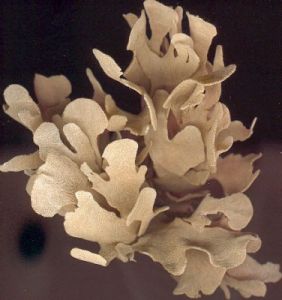
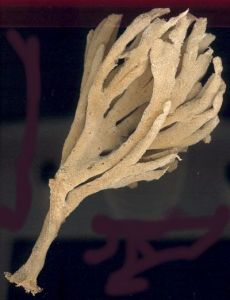 Storms and tides may bring an assortment of marine animal life up onto the beach. On the left is Hornwrack, a colonial animal known as a bryozoan, but looking rather like dead seaweed.
Storms and tides may bring an assortment of marine animal life up onto the beach. On the left is Hornwrack, a colonial animal known as a bryozoan, but looking rather like dead seaweed.
On the right is the skeleton of a branching sponge, probably Haliclona oculata, also known as Mermaid's glove.
Back to Sites

 Depending on currents, winds and the tides, seaweeds may become detached from their anchoring points and deposited on the beach. Various wrack species, sugar kelp and bootlace weed are common. Red seaweeds can be more difficult to identify, and many do not have common names. Here are just two. On the left is probably Calliblepharis ciliata, with attractive fringes but sadly without a common name. The one on the right is Red Rags, Dilsea carnosa.
Depending on currents, winds and the tides, seaweeds may become detached from their anchoring points and deposited on the beach. Various wrack species, sugar kelp and bootlace weed are common. Red seaweeds can be more difficult to identify, and many do not have common names. Here are just two. On the left is probably Calliblepharis ciliata, with attractive fringes but sadly without a common name. The one on the right is Red Rags, Dilsea carnosa.

 Various shells can be found, including Slipper Limpet (right), razor shells and Common Oyster. The Slipper Limpet, with a characteristic ledge inside, has arrived from North America, and now forms major colonies on the sea-bed of the Solent. It has a curious life history, starting out as male, and changing to female. The limpets form long stacks, with the female at the bottom and males above.
Various shells can be found, including Slipper Limpet (right), razor shells and Common Oyster. The Slipper Limpet, with a characteristic ledge inside, has arrived from North America, and now forms major colonies on the sea-bed of the Solent. It has a curious life history, starting out as male, and changing to female. The limpets form long stacks, with the female at the bottom and males above.
 Storms and tides may bring an assortment of marine animal life up onto the beach. On the left is Hornwrack, a colonial animal known as a bryozoan, but looking rather like dead seaweed.
Storms and tides may bring an assortment of marine animal life up onto the beach. On the left is Hornwrack, a colonial animal known as a bryozoan, but looking rather like dead seaweed.